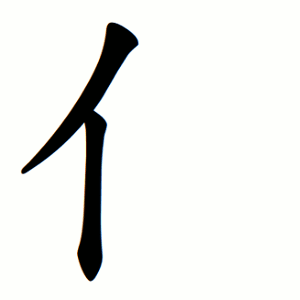Radicals 16-20 (4 of 30)
antony73
June 08, 2009, 09:53 PM posted in General Discussionjiōng 'borders'

Strokes: 2 Examples: 冉 同 肉
笔画: shú héng zhé gōu.
Although this Radical has four bǐhuà, it has only two strokes. Héng zhé gōu are counted as one stroke as the pen or brush shouldn't leave the paper while writing it.
bā 'eight'

Also 丷
Strokes: 2 Examples: 公 分 兰
笔画: piě nà. 丷 uses diǎn then piě
rù 'enter'

入 and 人 (below) are together as one Radical.
Strokes: 2 Examples: 入 汆 兪
笔画: piě nà.
rén 'person'


亻 also means 'person,' but a 'male person' as in 他,compared with 她.
Strokes: 2 Examples: 令 从 介 / 仆 仇 仍
笔画: piě nà. 亻 uses piě then shù
bāo 'wrap'

Strokes: 2 Examples: 勿 勾 够
笔画: piě héng zhé gōu
bǐ 'ladle'

Strokes: 2 Examples: 化 北 匙
笔画: piě shù wān gōu
I thought I would end this post by sharing this very endearing word one of my Chinese friends taught me recently: 心电感应 (xīn-heart diàn-electric gǎn-feel yìng-answer/respond).
In one dictionary this word comes up as Telepathie, however, I asked her for the Chinese equivalent of Connect, as in that special connection you have with some one you love.
心电感应 not only sounds beautifully poetic, but its sentiments in each part really do sum up and capture the idea of that special connection of hearts and souls we sometimes share.
Sources: http://en.wiktionary.org/wiki/Index:Chinese_radical#1_stroke / http://www.mdbg.net/chindict/chindict.php / http://www.kzxy.com.cn/Article/ArticleShow.asp?ArticleID=17116#%E4%B8%80%E7%94%BB%EF%BC%885%EF%BC%89 / William McNaughton's Reading and Writing Chinese. Tuttle Language Library
changye
June 09, 2009, 02:30 AMThere was no distinction between 他 (he) and 她 (she) in Chinese until about a hundred years ago. In other words, the character 他 indicated both "he" and "she" before the 20th century.
她 gradually began to be used in the sense of "she" in China in the first half of the 20th century, which was a result of influx of European languages in those days. Incidentally, the greeting "你好" was "officially" adopted as an equivalent of "Hello/How are you?" in the 20th century.
For the record, the character 她 originally indicated "mother" in ancient Chinese, and later it began to indicate "elder sister/woman". The original form of 他 was 它, and 它 originally meant "a snake" (= 蛇) in the early stage of Chinese characters.